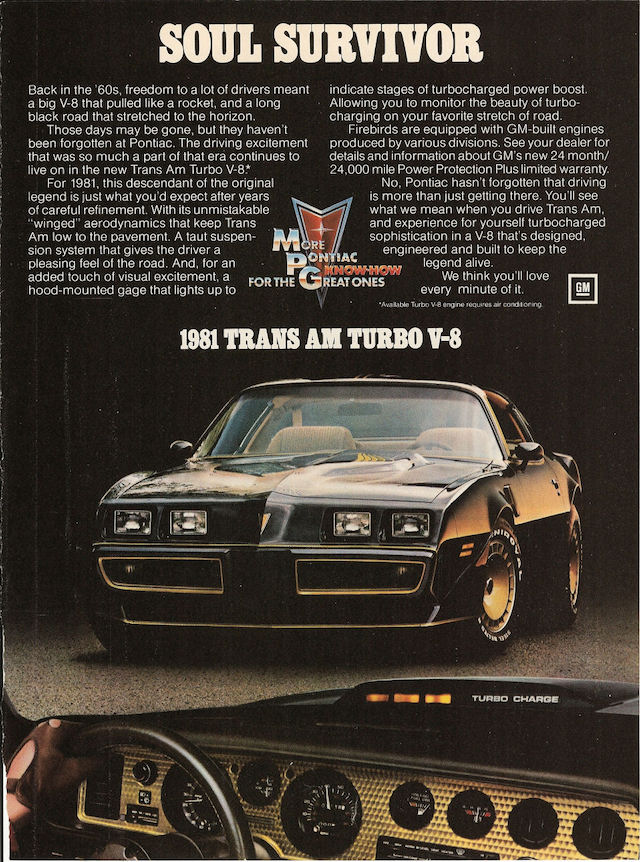SOUL SURVIVOR. – Rants – Autoextremist.com ~ the bare-knuckled, unvarnished, high-electron truth…
[ad_1]
By Peter M. DeLorenzo
Detroit. That I have a deep enjoy of everything Pontiac is well identified. I grew up immersed in this enterprise – appropriate in the thick of GM’s heyday – and Pontiac played a very important purpose in both equally my formative years and my early marketing occupation. That’s why when GM took the personal bankruptcy tablet in 2008, I was crushingly unhappy to discover that the Pontiac Division was just one of the assets to be jettisoned. (And Hummer, also, but fortunately that nameplate has now returned.)
It is hard to imagine now, but Pontiac was just an additional GM division back again in the mid-50s. It had a lineup of stodgy automobiles, and there was nothing to produce house about. The division existed beneath the GM corporate umbrella, but it was decidedly lacking in just about every thing when in contrast to GM’s other divisions: Buick, Cadillac, Chevrolet and Oldsmobile. But that would all change when Bunkie Knudsen was appointed a GM vice president and the division’s general supervisor in July of 1958. Knudsen was offered the assignment to inject some daily life into the division and increase product sales, and he was provided carte blanche to do it.
As a reminder, if you had been a GM vice president and divisional normal supervisor again in the working day you had been akin to a potentate functioning a small state. GM’s divisional normal managers experienced immense electrical power with obligation for engineering, manufacturing, income and marketing. Contemplating about that in comparison with how matters function currently, it doesn’t seem true, simply because it was so radically various from today’s car business enterprise it is like looking at from a fairytale e book. But make no blunder, it was really real, and GM’s divisional normal supervisors were like giants roaming the earth, swashbuckling their way via the working day-to-day of the business enterprise though producing very important, pivotal decisions on the fly. Don’t forget, this was a business enterprise that debuted new vehicles every slide with new sheet metallic and new capabilities to go with them. Once more, in comparison with how items are performed now, it is just jaw-dropping to contemplate how the company churned back then. Yes, as I’ve said lots of, quite a few instances just before, it was a distinct time and a diverse era, but GM’s heyday was truly impressive in that the corporation soared simply because of it, even with the bean counters striving to rein factors in each and every step of the way.
The only arena exactly where GM’s divisional standard administrators experienced to consider a action back again was when dealing with GM Styling, which was operate with an iron fist by style and design legend Monthly bill Mitchell, who inherited the mantle from Harley Earl. The clashes involving Mitchell and GM’s divisional typical administrators ended up famous, and I will help save those tales for a different column. But suffice to say, Mitchell got what he wished for the most component, even if he experienced to participate in the divisional normal managers off towards just about every other to do so.
But again to Bunkie and Pontiac. His 1st hires were two youthful and gifted engineers – Pete Estes from Oldsmobile and John Z. DeLorean from Packard. The cost to DeLorean was extremely distinct: get Pontiac into the general performance business appropriate now. And because Bunkie was a massive racing fanatic, everything was on the desk, from NASCAR to drag racing.
And all of a unexpected, incredibly hot Pontiacs stuffed with huge V8s started to exhibit up almost everywhere, from Daytona to Pomona. And even in our driveway. Considering the fact that Bunkie and his wife had been social friends with my mom and dad, Bunkie started off sending the best Pontiacs to our residence specially for my mom to push. Beginning in the summer season of 1959, we had a collection of Bonneville and Catalina convertibles that had been normally vivid red with a white prime and a vivid pink interior. And they were constantly equipped with the best Pontiac motor at the time, which at 1st ended up 389 cu. in. V8s with 3×2-barrell carbs, and eventually 421 cu.in. V8s. Useless to say, my mom liked her sizzling Pontiacs. (And my brother and I did, way too, primarily given that he experienced just gotten his license and we would “exercise” mom’s cars and trucks at every possibility.)
The transformation of the Pontiac Division is a glorious portion of GM lore. Pontiacs went from currently being useful transportation products to some of the best cars in the industry. Presenting effectiveness engineering and styling that just weren’t offered any where else, Pontiac rode a wave of popularity that took the business enterprise – and GM – by storm.
I say GM mainly because, recall that part about GM’s divisional vice presidents being akin to potentates of their individual international locations? Effectively, that was true, until eventually Pontiac – underneath Bunkie Knudsen’s tutelage – began to upset the pecking order inside the company. Ahead of Pontiac became a “problem” for the other basic administrators, the GM divisional hierarchy was crystal clear: Cadillac was up and off to the aspect luxuriating in its very own rarified world. Buick was next in conditions of status, with the super-preferred Chevrolet sucking up all of the air in the home due to the fact of its amazing sales quantities, adopted by Oldsmobile, which just chugged along, and then the moribund Pontiac.
At least that’s the way it applied to be ahead of Bunkie and his “pirates” got rolling. All of a sudden, matters had adjusted. Chevrolet, which pretty a great deal had higher-functionality internet marketing alternatives cornered inside GM, was getting significantly pushed by Pontiac on all fronts. Chevrolet operatives grew to become a lot more incensed with each individual Pontiac foray into their territory, and the intramural battles among the two divisions spilled more than all the way to GM’s vaunted 14th floor, with whining Chevrolet executives complaining to major GM execs that Pontiac was intentionally encroaching on Chevy’s territory. As you can think about, this did not sit properly with Knudsen and DeLorean & Co. The rising profits quantities, nonetheless, ended up in Pontiac’s favor so GM’s top rated execs very a great deal allow Pontiac go, which additional even extra gas to Chevy’s fire.
Then, in 1963, when GM issued its official ban towards the participation in racing as company plan (a monumentally chicken-shit decision, by the way), the divisional standard administrators experienced to comply. (This is when Zora Arkus-Duntov, alternatively than destroying the Corvette Grand Sports activities, sent them to reliable racer mates of the company, for essentially free. And the company’s deeply embedded marriage with Jim Hall’s Chaparral autos went fully underground.)
The tiny-recognised collateral damage from that anti-racing ban was a GM internal edict that prohibited particular sized V8 from remaining set in “smaller” autos, which is a joke taking into consideration people scaled-down automobiles were being enormous by today’s specifications. The Chevrolet operatives dutifully complied with the edict, while Pontiac operatives, led by DeLorean and Invoice Collins – the gifted engineer who deserves most of the credit rating for this up coming piece of automotive historical past – determined to go in a further direction. In advance of the racing ban, Collins experienced been hectic stuffing Pontiac’s 389-cu.in. V8s into “intermediate” Le Mans bodies, and the end result was, unnecessary to say, magical. But when the edict took result, Pontiac was exclusively ordered not to things a V8 into a Le Mans to make it into a new Pontiac product.
Then, a little bit of genius. Pontiac operatives determined to get all around the ban by earning the “GTO” a new option bundle on the 1964 Pontiac Le Mans. And the rest, as they say, is automotive background, as the primary “muscle” motor vehicle was born. Chevrolet operatives ended up apoplectic, but by the time GM company got wind of what was occurring, the GTO selection experienced turn into one of the most sought-soon after high-performance option offers in the marketplace. And by 1966 it turned its own separate model.
Pontiac was purple-hot, with its unique brand of large-functionality engineering and some of GM Styling’s ideal styles coming in wave soon after wave. From there, Pontiac would pile success on results, achieving, at just one position, 3 million in once-a-year profits. The rebels out in Pontiac, Michigan, experienced won.
And pretty much the ideal section? Pontiac was supported by sensational advertising, clearly some of the greatest and most unforgettable promoting in the car business enterprise at the time. That pissed off Chevrolet’s advertisement agency – Campbell-Ewald – on a normal foundation, which created it even much better.
As for the intramural struggle concerning Chevrolet and Pontiac, it ongoing. Pontiac arrived out with the Grand Prix in 1962, and the lengthy-nosed ’69 model pushed by DeLorean was yet another massive hit. Chevrolet came out with the Camaro in 1967, but the Pontiac Firebird to some, was far better searching. The ’70 Camaro, which was extraordinary in its own correct, was undercut by the fabulous ‘70 Pontiac Firebird Trans-Am and Firebird System. As late as 1984, when Pontiac came out with the mid-motor Fiero, the fight ongoing. Chevrolet insisted that it could not encroach on Corvette territory, so the Fiero was limited to a 4-cylinder at intro and acquired a V6 correct right before it was dropped. The 2nd-era Fiero, which I experienced the pleasure of viewing, had “Corvette-killer” published all in excess of it, but there was simply just no way Chevrolet operatives had been likely to enable it to see the light-weight of day, so they lobbied from it heavily, and it never did.
The Pontiac tale is well worth telling. And it’s not just simply because of the magnificent automobiles and nameplates like Bonneville, Catalina, Fiero, Firebird, Grand Prix, GTO and Le Mans. It’s mainly because a bunch of maverick Genuine Believers thumbed their noses at the corporate inertia that threatened to overrun GM at the time and dared to go up against an intramural company rival to deliver some of the very best and most unforgettable devices to appear out of Detroit.
I had the pleasure of functioning on Pontiac promoting at D’Arcy MacManus & Masius from 1980-1985, and I will under no circumstances fail to remember it. Even while the company was speedily switching and Pontiac was commencing to lose its identification within just the GM company monolith, the spirit of the previous advert greats that came before me and my advertisement colleagues was as extreme, vibrant and visceral as it could be. And we labored to make them very pleased each damn day.
Is this a plea for GM to resurrect Pontiac? That is a tricky “no.” Pontiac existed in a fleeting moment in time and remaining its indelible mark on automotive historical past – never to be recurring, but under no circumstances to be forgotten.
And that is the Significant-Octane Fact for this week.
 (Pontiac)
(Pontiac)
Editor’s Note: This is Peter’s well known advertisement for the 1981 Pontiac Trans Am Turbo V-8. As Peter says, “It was a distinctive time and a different period.” Truer words were being never spoken. -WG
[ad_2]
Source hyperlink







